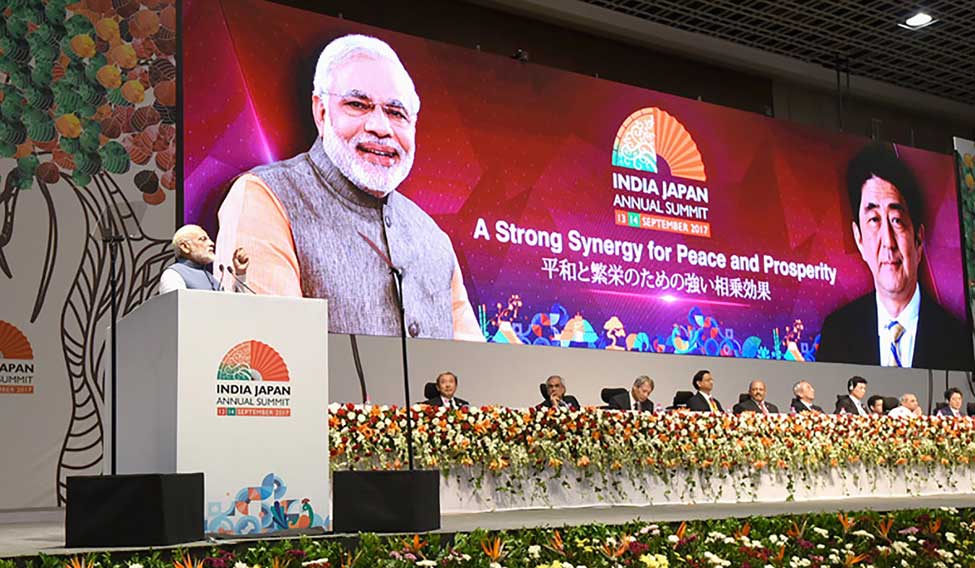Nirmala Sitharaman was sworn in as a cabinet minister on Sunday September 3, but unlike other new-comers and promotees, she didn't take charge of her new portfolio, defence, the next day. She waited two days—not for an auspicious hour, but for her predecessor to fly to Japan, and return after taking part in the the India-Japan annual defence ministerial dialogue.
“It is a very important security dialogue between the two countries ahead of the Japanese prime minister’s visit and therefore changes are not advisable. I will continue for next two days to complete the dialogue, and Ms Sitharaman will take the charge of the ministry as soon as the dialogue ends,”Jaitley said before he emplaned for Japan.
The two-day delay in the ceremonial changeover in South Block showed the importance that India accords to defence ties with Japan, a country which, ironically enough, had come closest to invading India three quarters of a century ago, and which held no strategic value to India till about a decade and half ago. Today, the two are exchanging notes over the actions of their common rival China, and seriously plotting over and under the Indian Ocean.
Literally so. The official statement issued after Jaitley met Japanese defence minister Itsunori Onodera said so clearly: “The Ministers exchanged views and ideas with the aim to further strengthen defence and security cooperation under the framework of the Japan-India Special Strategic and Global Partnership.” It also said that the two “will consider inclusion of anti-submarine warfare (ASW) training to expand cooperation. In addition the ministers agreed to pursue exchanges and training by ASW aviation units such as P-3C [anti-submarine and maritime surveillance aircraft]”. And at next year's Malabar exercise, Japan will be allowed to bring its first indigenously built maritime patrol aircraft, the Kawasaki P-1.
Japan joined the Malabar naval drill, earlier held between Indian and the US navies two years ago, and has since brought its helicopter carrier JS Izumo in the anti-submarine part of the exercise. This is significant considering the increased Chinese submarine activity in the Indo-Pacific waters.
Both are clearly wary about both the rising and deepening presence of China in the Indo-Pacific region, which itself is a new geostrategic concept. Indo-Pacific is a term coined over the last half decade by strategic thinkers in the US and Australia, in a bid to give a new identity to the geopolitical region where India, Japan, Australia and China will be the major players. India had been vary of using the term till recently, for fear of being accused of strategic overreach.
The shyness has been shed. Perhaps the most important strategic take-away from the Modi-Shinzo Abe summit has been that India has come to formally recognise the new geo-strategic term 'Indo-Pacific'. The term figures about a dozen times in Modi's joint statement with Shinzo Abe!
The Japanese seem to have really drawn India out into the Pacific. India had been till now making only principled statements about the newly-unfolding Korean crisis, which it had been viewing as a problem of the Pacific region. Now both Jaitley and Modi have issued open statements condemning North Korea's sabre-rattling.
Japan, which had till now professing pacifism, has very little military muscle to show off in the Indo-Pacific in terms of deployable forces or weapon platforms, but still possesses strategic technologies. During the Jaitley visit, Japan agreed to collaborate on dual-use technologies, and collaborate on research in unmanned ground vehicles and robotics, an area in which Japan is light years ahead.
Though no breakthrough was achieved in the much-vexed issue of sale of US-2 amphibious aircraft, which costs an astronomical sum of $109 million per piece, the two agreed to talk further. India also will seek to draw Japan into its Make-in-India initiatives in defence. Japanese submarine-builders Kawasaki and Mitsubishi have also been invited to bid for Project-75, India's forthcoming project to build six diesel submarines at a cost of $ 7.8 billion. They will compete with the tried and tested manufacturers from Russia, France (DCNS who are making the Scorpenes), Germany (HDW), and two other newcomers to the Indian market—Spain's Navantia, and Sweden's Kockums.
The major hurdle in cooperating with Japan in defence manufacturing is the cost. Japanese technologies, especially critical defence knowhow, are priced higher than western technologies. However, Japanese officials say that the costs are high because Japan had not been a defence exporter till three years ago, and now the market forces should push the prices down.





